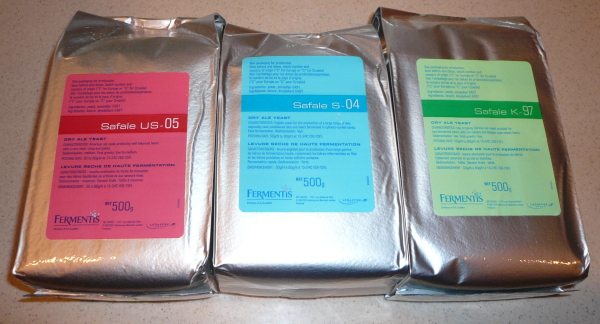JnJ
Well-Known Member
I've had great success with dry yeast. I will only use liquid when there is not a compatable dry yeast available. This weekend was the Hefe, so I used liquid.

mew said:I think someone posted here a while back saying that saflager was too estery for superclean lagers. But unless that person speaks up, I'll give saflager a try.












LykeAFox said:Question on saving yeast: Do you have to wash the yeast or can you just rack it to sanitized bottles? I have seen both and wasn't sure which was preferred (the best?) If I had to guess I would think that washing it would be for more long term storage.
LykeAFox said:Question on saving yeast: Do you have to wash the yeast or can you just rack it to sanitized bottles? I have seen both and wasn't sure which was preferred (the best?) If I had to guess I would think that washing it would be for more long term storage.
brloomis said:Think about the stuff that's in a yeast cake: hop resin, break proteins, lots of dead yeast cells, vegetable matter from the grains and hops, etc. Why would you want to put that junk into a nice new wort?
Bobby_M said:You can be really careful but the more you play with it, the riskier it gets (kinda like a Vietnamese massage parlor).

Bobby_M said:Sound reasonable in theory but when you think of it, it was just sitting in your "old" delicious brew. If it's all that nasty, it would have ruined the previous batch too. When you pitch that slurry, most of the heavy particulates just go back to sitting on the bottom along with the stuff introduced on the new batch.
I've only gone as far as pitching unwashed slurries so far and one of the reasons I haven't played the wash game is fear of introducing contaminants through open air pouring etc. You can be really careful but the more you play with it, the riskier it gets (kinda like a Vietnamese massage parlor).

Yes, you always aerate before pitching any type of yeast.AdIn said:All that experience pretty convincing. I think I'll try Saflager W-34/70 which is suppose to be equivalent of Bohemian 2124 for my next octoberfest. Do you aerate the wort before pitching rehydrated yeast?
the_bird said:I pitched a rehydrated packet of s-04 in my oatmeal stout yesterday (I swear, that yeast seems to proof, not just rehydrate, when you put it in warm water). Took off actively within eight hours...
jbreiding said:i prefer my yeast to not impart any flavors so i can taste the malt!
Yuri_Rage said:The mailman was a good man today!

That's 1500 grams of dry yeast - roughly enough for fifty 15 gallon batches! Unfortunately, I can't post the source, as it was a favor from a friend. However, I don't think I'll be needing any yeast for a while! Vacuum sealed in sanitary conditions, this stuff lasts for a LONG time.
brloomis said:But, at some point you do rack the beer away from the yeast cake/trub in order to avoid problems with head retention, flavor stability, off flavors, and infection. If you pitch a new wort onto an old cake, wouldn't it increase the possiblity of these bad things happening?
Yuri_Rage said:The mailman was a good man today!

That's 1500 grams of dry yeast - roughly enough for fifty 15 gallon batches! Unfortunately, I can't post the source, as it was a favor from a friend. However, I don't think I'll be needing any yeast for a while! Vacuum sealed in sanitary conditions, this stuff lasts for a LONG time.
the_bird said:What's the K-97? Never heard of that...
jfrizzell said:According to Fermentis: A German ale yeast selected for its ability to form a large firm head when fermenting. This top cropping ale yeast is suitable for top fermented beers with low esters levels and can be used for Belgian type wheat beers. Sedimentation: low. Final gravity: low.
They are typically only sold at a wholesale level. I looked pretty hard for an online supplier, and I didn't have a whole lot of luck. That's when fate stepped in, and I got a bit of a lucky break.Bobby_M said:I'd imagine these bricks are meant for commercial breweries but why would they be so difficult for homebrewers to get them?
kappclark said:Everyone seems to be posting about Nottingham.
Any comments about Windsor ? I did a test between the 2 on a partial mash, and the Nottingham seemed better ... can't really describe why I liked it better...
doublegun said:We did a True Brew Wheat kit, used Windsor at our LHBS guy's recommendation. Not quite true to style, but an exceptionally good American wheat beer was the result. Try it.